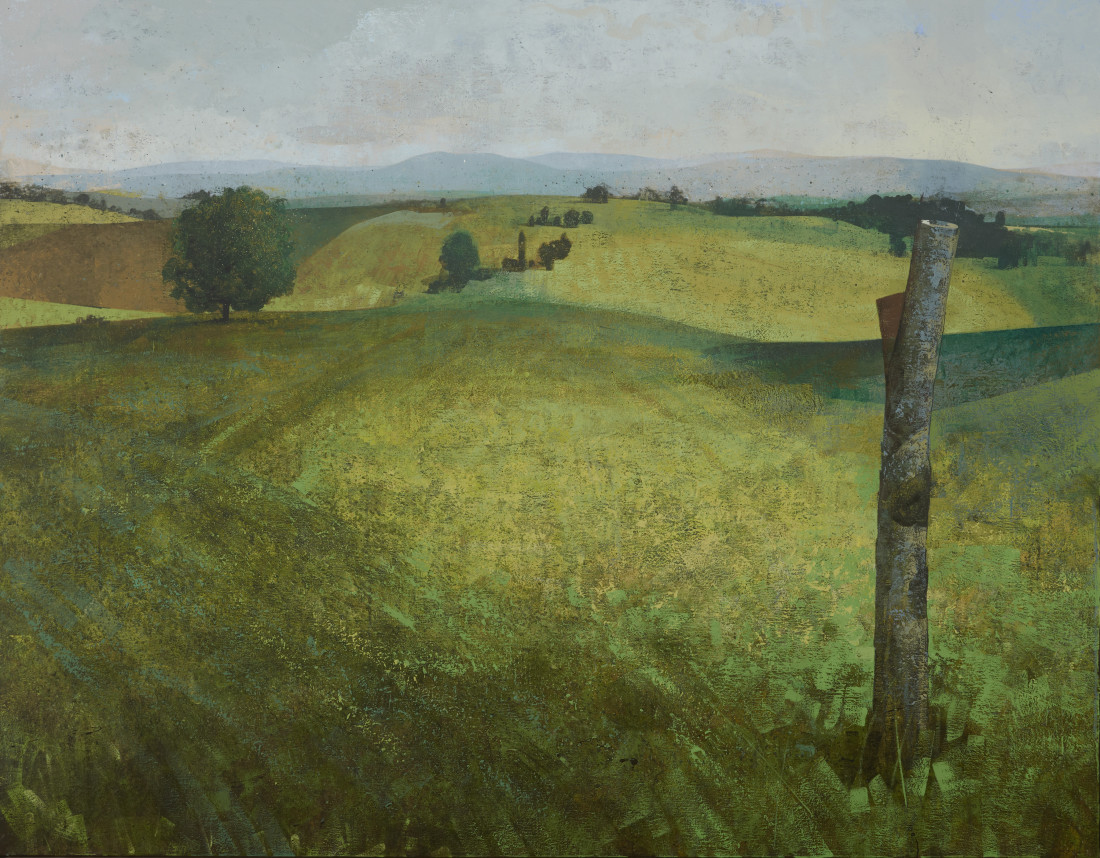“The appreciation of natural beauty and the painting of landscape is a normal and enduring part of our spiritual activity,” the art critic Kenneth Clark wrote in 1949. In New Terrain — on display at Blue Spiral 1 through Friday, Aug. 28 — this spiritual activity is examined, showcased and refracted in the paintings and sculptures of Hoss Haley, Robyn Horn, Charles Ladson, Peggy Root and Hannah Skoonberg.
Landscape is an old and sometimes undervalued painterly tradition. It goes back several thousand years in China and nearly as far back in the West, depicting wide vistas of natural scenery in a unified system of perspective. The seed of New Terrain lies in the landscape paintings of Root and Ladson, two painters showing the genre’s range, from Root’s forthright field work to Ladson’s dreamlike narrative approach.
“We had these two very different sides of the landscape from these two very different painters, and we wanted to fill the gaps with some sculpture,” says Michael Manes, Blue Spiral 1’s assistant director. The sculptures of Haley and Horn suggest the structural underpinnings of a landscape in their geometry, and like the graceful prints of Skoonberg, the art objects themselves function as enacted landscapes. “The artists are all very different, using very different mediums. Landscape is the string that attaches all of them,” says Manes.
The Chinese tradition of three-dimensional landscapes is visible in the work of Horn, a wood sculptor using pieces of the natural environment to create geometrically minded monoliths that evoke formations of stone, wood and water. Horn says the basis of her work is “the process of wood materializing into stone shapes,” and in these surfaces exist entire topographies.
Haley works primarily in steel. “It rusts,” he says, “it shows age, it deteriorates.” The work displays a tension between the order imposed by humans and the uncontrollable forces that resist that order. His sculptures and works of paint or enamel on steel surfaces seem expressly created to be reclaimed by the forces of nature. Each piece becomes a landscape in itself, a monolothic element that is acted upon by its environment.
Hannah Skoonberg’s prints are figurative and delicate, seemingly at odds with the brawny blocks of Haley’s or Horn’s work. Skoonberg’s prints are less focused on the larger vistas favored by the show’s two painters, instead dialing in on figures representative of those landscapes. “Quilt,” her piece woven from tiles cut out of cyanotype prints, creates a literal landscape from representations of nature, in a craft tradition tied intimately to the natural resources of the American South. This focus on texture, on the landscape of the art object itself, can be traced throughout the works in this show.
Root’s work is perhaps the most accessible of the exhibition, painting scenes from life in the tradition called en plein air, but her method and her end result are similarly focused on process. She emphasizes that each piece is “a meditation in paint on a particular place at a particular time and what it feels like,” a statement that reflects the Eastern strain of landscape painting and also closely echoes Skoonberg’s philosophy of landscape art as a kind of meditation. Look closer at Root’s work, and the thick brush strokes and bold framing have more in common with Haley’s geometric sculptures or Ladson’s suggestive narration than one might expect.
Ladson’s paintings straddle the border between narrative and en plein air landscape painting, concerned as they are with the interplay of color, texture and space. Much of his work suggests photographs recently vacated by their human subjects or oblique frames cropped from more explicitly narrative images.
His and Skoonberg’s works are neat intersections of two conceptual poles in this exhibit — the tradition of landscape painting as a representation of an observed natural environment on one hand, and a concern with landscape as a literal feature of the art object on the other. The interplay between form and content in this show, wherein content consists of the representation of natural forms, becomes pleasurably blurry, creating connections between disparate styles and mediums that allow viewers to question and reinterpret landscape as a genre.
“I think the idea of landscape as metaphor really shows in [Ladson]’s work,” Manes says. “Maybe less so with [Root’s], because it’s more straightforward, but I think by putting their work next to each other, you can really make that connection. And then of course with these sculptural pieces, it does push the boundaries of what it means to work in landscape. We didn’t call it ‘New Landscapes,’ we called it New Terrain.”
WHAT: New Terrain
WHERE: Blue Spiral 1, bluespiral1.com
WHEN: Through Friday, Aug. 28.



Can the editors tell us something about your new arts columnist?
My childhood was typical: summers in Rangoon, luge lessons. In the spring we’d make meat helmets. When I was insolent I was placed in a burlap bag and beaten with reeds, pretty standard really. At the age of 12 I received my first scribe.
Still hoping that Margaret Smith or Ali Marshall will introduce their new arts writer and his credentials. Didn’t Ali introduce Jeff Messer as the new MX theatre critic? Arts reviewers earn more credibility with serious readers when they give serious replies to reader queries.
Professionalism is something I hope to develop. I apologize for offending you.
I’m a writer from Erie, Pennsylvania. I studied sculpture and creative writing. My professional background is in literature more so than journalism. I’ve been the poetry editor of a literary journal called Lake Effect for several years. If you have any specific questions, I’d be happy to answer them — elliot.emory.smith@gmail.com.
I’m sure your professionalism will grow as you gain experience. I’ll be reading your reviews with interest.